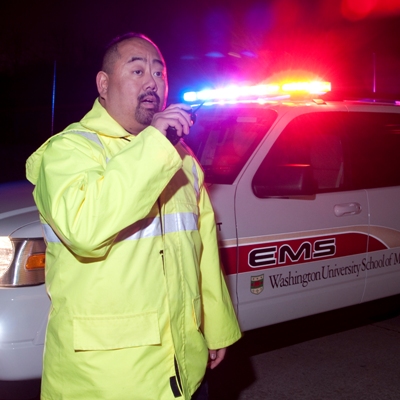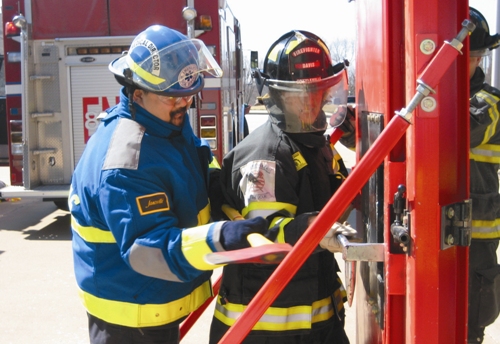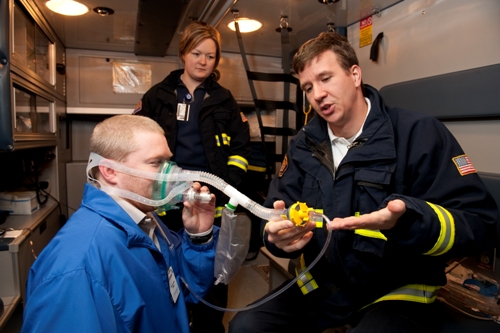Barnes-Jewish leads emergency care in the hospital and in the field

In the crucial minutes after a devastating auto accident, the victim often remembers very little. The impact and ensuing sirens of ambulances, police and fire trucks become background noise as emergency medical service (EMS) personnel rush to the scene. Pre-hospital physicians are fellowship-trained to provide care before patients arrive at the hospital and supervise the care and training of EMS providers and paramedics.
Composed of subspecialists within emergency medicine, Washington University EMS is the first and only physician-based emergency medical response agency (EMRA) licensed in the state of Missouri. When area fire and police departments or ambulance services call the hospital emergency department for help, physicians head to the scene in specialized emergency response utility vehicles. Each is equipped with sirens and lights, defibrillators, advanced airway instrumentation, medications—everything needed to save a life in the first few minutes of a critical emergency.
First responders
Missouri law requires that paramedics who perform advanced life support do so under the authority of a licensed physician. Washington University EMS physicians have been chosen to oversee the three largest EMS agencies in the St. Louis area: Abbott Ambulance, the St. Louis Fire Department and the Christian Northeast Hospital EMS. The physicians also work with smaller agencies and pre-hospital operations. Barnes-Jewish Hospital, through its emergency and trauma communication center, serves as the medical control hospital for these ambulance companies, managing the flow of patients and helping to assign physicians to serious cases.
In addition to providing care themselves, Washington University EMS physicians also train paramedic staff members.
“Our modern EMS approach aims to develop our prehospital colleagues: EMTs, who give basic life support; paramedics, who can do invasive airways and other advanced procedures; and to some degree the first responders such as police or firefighters, who typically are individuals who can offer basic first aid,” Tan says.
While all EMS programs must have the oversight of a supervising physician and hospital, this is the only program in the region that routinely sends physicians along with ambulances for certain patients and also performs periodic ride-alongs to make sure quality and patient safety are at the highest levels. A typical week might include a physician going on a dozen or more ambulance calls. Tan and his EMS colleagues provide medical oversight both indirectly, through written standard procedures, and directly, by responding to paramedics’ calls for permission to administer medications.
Oversight also includes clinical quality assurance and continuous quality improvement.
Training for the future

A year-long EMS fellowship program at Washington University and Barnes- Jewish Hospital prepares emergency medicine physicians to specialize in the clinical and operational aspects of pre-hospital care. One to two fellowships are awarded each year. The future field physicians engage in fire rescue, urban and rural search and rescue, air and ground ambulance transport and mass-gathering and events medicine. They also receive SWAT, hazardous-materials and National Incident Management System training.
Such extensive preparation equips them to become future medical directors and chief EMS physicians. “Our job is to make sure that medical care provided in the community under our oversight is scientifically sound and compassionately delivered.”
To help nurses and EMS staff collaborate in the care of patients, Tan also created a nurseto- paramedic bridge fellowship. Alex Stringer, RN, a nurse in the Charles F. Knight Emergency and Trauma Department at Barnes-Jewish Hospital, will be one of the first graduates. It is not something he is required to do, but Stringer thinks it will ultimately make a big difference to patients.
“It helps me understand what patients go through out there before they get to the hospital,” Stringer says. “Once a patient comes to see us in the emergency department, we say they are ‘in our house’ but as an EMS provider you are out there in the patient’s house, dealing with their families and providing care.”
Getting your hands dirty
EMS work in the field can be dangerous. Washington University EMS physicians frequently provide care in chaotic settings. They have climbed down a steep, muddy ravine to reach a wrecked car at the bottom, helped fire victims and the firefighters themselves while nearby structures were in flames and entered hostile settings where even doctors are viewed with suspicion. “Providing the injured, the ill and those who might die with the very best medical care possible, under difficult circumstances, is what our physicians do,” says Tan.
Washington University EMS physicians and many of their colleagues in the division have rushed to assist communities when disasters occurred, lending medical assistance after 9/11, Hurricane Katrina, and the Haiti earthquake of 2010, and rushing to regional and local disasters such as the 2008 floods in southern Missouri, where Tan oversaw medical support operations for search and rescue.

Brian Froelke, MD, emergency medicine physician and the EMS Fellowship Program’s first graduate in 2007, is the medical director for the state-affiliated disaster medical team, MO-1 DMAT, Inc (the Missouri-1 Disaster Medical Assistance Team). Together with its federal counterpart, MO-1 DMAT provides everything from a small strike team that furnishes medical staffing wherever needed to a fully equipped 50-bed hospital tent with attendings adjacent to an incapacitated facility. During the ice storms that paralyzed much of the St. Louis area in 2006, Froelke’s medical experts stepped in.
“We want to be sure we are prepared to handle anything for our community when the need arises,” says Robert Poirier, MD, chief of clinical operations in the emergency department. Whatever the special situations, Washington University EMS physicians adapt, resolving problems from deluges of patients during flu outbreaks to on-sight trauma emergencies.
Emergency medicine physicians not only serve as a safety network for the general public in the St. Louis area through EMS and in-hospital services, they maintain a safety net for citizens with unmet health, social or mental health needs. More than 40 percent of patients who visit the emergency department have little or no health insurance, no primary care physician and may be indigent or homeless. Emergency physicians are often their sole providers of medical care. They hear life stories and problems and try to help make these patients’ lives better by connecting them with resources that may exist in their area.